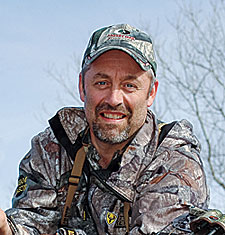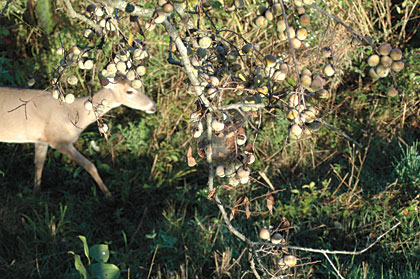October 28, 2010
By Bob Humphrey
 Bob Humphrey |
One advantage of living in the same area for a long time is familiarity with your hunting areas. After 20-some years of hunting the same haunts, I have several favorites and can usually predict well before hunting season whether they'll be productive in any given year. All I need to do is note the weather during the week in spring when the apple trees blossom. If conditions are right, it will be a good crop and those stands will produce. Otherwise, they're not even worth hunting.
It's no big secret how important apples can be to deer -- and to bowhunters -- in certain parts of the country. Astute bowhunters are also aware there is no more powerful deer attractant than a ripe persimmon. But apples and persimmons aren't the only members of a group of food biologists collectively refer to as soft mast. Furthermore, biologists are just now beginning to discover just how important soft mast is in a deer's diet.
Advertisement
It's understandable why soft mast has been overlooked in the past. Most deer diet studies are done by examining rumen samples (stomach contents) or fecal analysis. Because soft mast is highly digestible, it disintegrates very early in digestion and long before defecation. The result, according to Dr. Karl Miller, is that "Most food habit studies have underestimated, if not grossly underestimated, soft mast."
Late summer is a period of extremely high energy demands. Adult does are still nursing fawns, and antler growth in bucks is reaching its peak. Meanwhile, much of the herbaceous vegetation deer have been feeding on all summer has passed its peak nutrition and is beginning to die. Fortunately, a side effect of that process is ripening fruit. Hard mast such as acorns will have its day the coming weeks, but in early autumn, soft mast is king.
Advertisement
Soft mast consists mainly of what we commonly refer to as fruits, though there are some noteworthy exceptions. Botanically speaking, they are not all true fruits, though we'll use that term collectively to include the subgroups below.
Drupes
There are two general categories of soft mast known as drupes. The first grow as single or individual "fruits" such as apricot, cherry, peach and plum. The second grow as composite drupelets, and include members of the genus Rubus, such as blackberry, raspberry and dewberry. Of these, cherry and Rubus are probably most important as deer foods. Pioneer species such as blackberry, raspberry and wild cherry are among the first, and often most abundant, woody plants to appear in disturbed areas such as clear cuts. Their fruits typically ripen early and get gobbled up quickly, making cuts a good place to set up if your state has a very early bow season. Additionally, deer get conditioned to these areas and may continue to bed in them even after the berries are gone.
Pomes
Apples are, for the most part, unavailable until they ripen, the stems die and they drop to the ground, which is usually a gradual process. However, a heavy rain or windstorm may knock down a bunch, creating a short-term bumper crop for deer and deer hunters. Deer will feed on apples as soon as they hit the ground, but early fall feeding may be more casual. Once the frost hits them and their starches turn to sugar, however, they won't last long.
 Soft mast such as apples, persimmons and berries is an important source of nutrition for deer and presents a great hunting opportunity for bowhunters. |
In the early days of wildlife management, multiflora rose was widely promoted and planted to provide both cover and food for an array of wildlife species. Because it is an introduced species, and highly invasive, it has fallen out of favor with wildlife managers -- at least the more politically correct ones. However, it still provides the same benefit to wildlife, and deer love the red "hips" it produces every year in abundance. Both rose and hawthorn -- another pome producer -- often form dense thickets that make for nearly impenetrable bedding cover too.
Speaking of planting, it's an easy way to get more soft mast on your property. Increasingly, nurseries are developing and selling varieties of apples, pears and other soft mast producers designed to yield fruit at a young age. You can also turn neglected and unproductive fruit trees back into producers by a process known as releasing. Simply remove surrounding shrubs and trees that compete for sunlight and soil nutrients. Just be sure to leave enough so deer still feel comfortable feeding there in daylight.
True Fruits
True fruits include things such as blueberry and strawberry, which you may not think of as being particularly important deer foods. Bears, the ultimate gluttons, devour them to fatten up before their long winter nap; and deer aren't likely to overlook the opportunity either. Both species also grow wild, though they tend to ripen before most bow seasons open. Still, if you can find some remnants, hunt them.
Though they're often less abundant, it's hard to beat persimmons for their sheer degree of attraction to deer. When ripe persimmons fall, they become literal deer magnets. If the property you hunt has them, check regularly so you can jump on them when they ripen. If it doesn't, plant them.
They don't grow wild, but squash and pumpkins are also highly attractive to deer; so much so that one company, Heartland Wildlife Institute, even includes pumpkins in one of its food plot blends. Squash may go early, but the pumpkins won't get picked until just before Halloween, giving you a month or two to hunt the pumpkin patch and endear yourself to a farmer.
If you still aren't convinced soft mast is all that important, consider that it also includes soybeans and corn. Yup, both are fruits. Need I say more?
Tip Of The Month
Early autumn is hurricane and tropical storm season. Right after a storm is a great time to hunt around fruit trees because high winds will knock an abundance of fruit to the ground.

